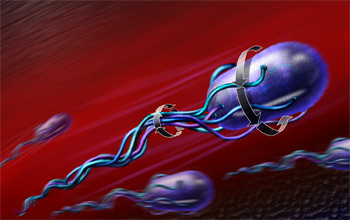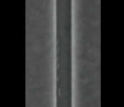News Release 05-109
Bacteria Take the Path of Least Resistance
Findings may lead to new nano-devices and understanding of infection

Escherichia coli cells use long, thin structures called flagella to propel themselves.
June 30, 2005
This material is available primarily for archival purposes. Telephone numbers or other contact information may be out of date; please see current contact information at media contacts.
Researchers have reported new information about how certain bacteria propel themselves from one place to another. Insight into bacterial micro-movement will benefit scientists and engineers developing nano-scale mechanical devices that may one day push fluids and transport molecules without the aid of pumps or electrical charges.
The findings, published in the June 30 issue of the journal, Nature, may also help elucidate how pathogens traverse the human body when causing disease.
Using a novel system of microscopic channels, Harvard University researchers separated individual Escherichia coli cells from their typical "swarm" and videotaped them as they swam over different types of surfaces. A laboratory workhorse and common gastrointestinal bacterium, E. coli, preferred to swim near a gel-like porous surface with characteristics similar to biological tissues rather than near a glassy, solid one. In fact, they swam next to the porous surface for much longer periods of time.
First author Willow DiLuzio said, "Now that we've established the bacterium's preference to swim toward a specific kind of surface, we hope to harness this basic information and focus on how to use it to direct movement in microfluidic, cell-based bioassays and sensors."
The team developed a new technique to fabricate microchannels only 10 microns wide, or one-tenth the width of an average human hair. The walls of the channels were either a porous agar or a solid, commercially available silicone-rubber compound.
E. coli use long, whip-like structures called flagella to propel themselves. Motors in the cell's wall spin the flagella into bundles that rotate counter-clockwise, creating a twist that causes the bacterium to rotate clockwise, or towards the right when viewed from above.
If cells were introduced to each end of the channel containing agar on the bottom, the cells preferentially swam on the right-hand side of the microchannel resulting in an ordered movement that resembled cars driving on a two-way street. And the microbes swimming closer to the agar surface moved faster than those swimming near the solid surface.
The authors propose that the bacteria closer to the porous surface experience less resistance and thus move faster.
"Because of E. coli's size, relative to the spacing of surrounding water molecules, it's analogous to a human trying to move through thick honey," said DiLuzio. "Now, an entirely new set of hydrodynamic properties have to be considered in order to understand their movement as well as replicate it in man-made nano-devices."
The surfaces of cells in the human body are often coated with a layer similar to agar. Future research into microbial movement will also be helpful in understanding how human infectious diseases develop and how infection might be halted in the body.
DiLuzio is supported by the National Science Foundation's Education Human Resources directorate through an award made to Harvard's Integrated Training Program in Biomechanics.
-NSF-
-
View Video
Real-time video of Escherichia coli cells swimming in a 10-micron wide microchannel.
Credit and Larger Version
Media Contacts
Richard (Randy) Vines, NSF, (703) 292-7963, email: rvines@nsf.gov
Principal Investigators
George Whitesides, Harvard University, (617) 495-9430, email: gwhitesides@gmwgroup.harvard.edu
The U.S. National Science Foundation propels the nation forward by advancing fundamental research in all fields of science and engineering. NSF supports research and people by providing facilities, instruments and funding to support their ingenuity and sustain the U.S. as a global leader in research and innovation. With a fiscal year 2023 budget of $9.5 billion, NSF funds reach all 50 states through grants to nearly 2,000 colleges, universities and institutions. Each year, NSF receives more than 40,000 competitive proposals and makes about 11,000 new awards. Those awards include support for cooperative research with industry, Arctic and Antarctic research and operations, and U.S. participation in international scientific efforts.
Connect with us online
NSF website: nsf.gov
NSF News: nsf.gov/news
For News Media: nsf.gov/news/newsroom
Statistics: nsf.gov/statistics/
Awards database: nsf.gov/awardsearch/
Follow us on social
Twitter: twitter.com/NSF
Facebook: facebook.com/US.NSF
Instagram: instagram.com/nsfgov

